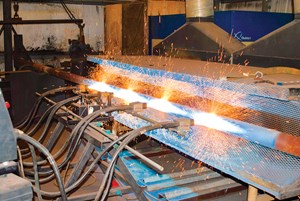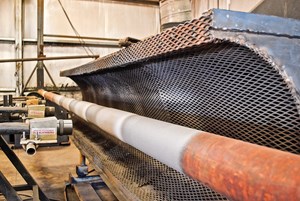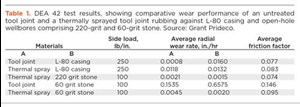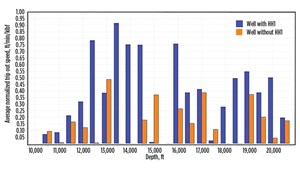Drill pipe life tripled, drilling operations optimized in Bakken laterals
A unique, atomized, metallic coating technology has emerged as one of the industry’s most viable options for protecting the vulnerable mid-section of drill pipe against the detrimental frictional and gravitational forces, emblematic of extended-reach horizontal drilling.
Notably, in North Dakota’s Bakken-Three Forks shale play, use of the non-welded wear band technology reduced wear tendencies, increasing drill pipe life up to 300%, while lowering downhole friction to increase drilling rates in increasingly longer laterals. By using the wear band technology, XTO Energy saved more than $800,000 in a multi-well drilling campaign, just by eliminating premature drill pipe replacement.
The methodology comprises a molten version of a proprietary iron alloy, designated as HH-1, which is applied with a low-temperature thermal spray system across a rotating section of drill pipe.1 The patented process results in the sectionalized deposition of durable and lubricious wear bands that provide a protective shield across the damage-prone mid-body of the drill pipe, Fig. 1. Moreover, unlike its ageless theoretical cousin, a typically welded process known as hardbanding, the non-destructive application of the wear bands has no adverse effects on pipe metallurgy.
The latest-generation wear band technology grew out of an earlier iteration used effectively in Exxon Mobil’s perennial record-setting Sakhalin Island campaign, long recognized as the poster play for extreme extended-reach drilling (ERD). More recently, the North American shale phenomenon has underscored the economic ramifications of earlier-than-desired drill pipe replacement, while accentuating the need to balance durability with optimum drilling rates, which are essential for the economic vitality of unconventional wells.
As the industry escalates the transition from predominately vertical to deviated well paths with increasing lateral lengths, and often drilled through highly abrasive horizons, additional forces are introduced that severely aggravate wear and restrict drilling efficiencies. In the Bakken, for instance, up to half of a typical drillstring had to be replaced after only one year of service in wells where the modus operandi is to push the technical limits of horizontal drilling.
ERD AND DP WEAR
Historically, as Redlinger, et al, pointed out,2 the technical proficiency of premium drill pipe was largely a given, and scarcely considered as an integral component in well planning and budgeting exercises. For perspective, consider that in the early 1990s, it was estimated that one 20,000-ft drillstring cost roughly $600,000 and had a seven-year lifespan.3 Assuming an average operational life of 21 years, each drilling rig would be expected to wear out three strings, totaling $1.8 million in up-front costs. Factoring in an additional $30,000/yr for full-rack inspections, repairs and downhole losses, estimated drillpipe expenditures amounted to a cumulative $2.4 million/rig over 21 years.
Flash forward and drillpipe durability and performance have drawn closer scrutiny, as extended-reach horizontal well geometries, penetrating harder and more abrasive formations, have become ubiquitous across the industry landscape. The exponentially higher costs of premature drill pipe wear in high-rate horizontal shale wells was brought to the forefront in the Bakken, where up to 400 joints of Range II (27 ft to 32 ft) pipe typically had to be retired after one year. At yearly replacement costs ranging between $680,000 to $880,000/rig, a 21-year drilling campaign, therefore, would result in incremental aggregate expenditures of $15 million to $18 million.
Beginning with the kick-off from vertical to often highly deviated lateral sections, horizontal drilling programs subject the drillstring to appreciably higher frictional torque and drag, which increase proportionately with depth and lateral reach. As the measured depth increases, these additional forces likewise dampen the ability to transfer sufficient weight-on-bit (WOB) to deliver economic drilling rates and maintain wellbore trajectory. Moreover, the frictional forces generated by the enlarged contact area between the mid-body of the drill pipe and the casing or wellbore, chip away at outer-diameter wall thickness. Tubular integrity is eroded further with the gravity-induced flexing motion of the pipe mid-body during rotation or tripping. All of these forces combine to accelerate the degradation of a drillstring from premium, to Class 2, to eventually damaged beyond repair (DBR).
The loss of mid-body OD wall thickness notwithstanding, the primary focus previously had been on protecting the premium tool joints, which are mandatory for higher-torque applications and in constant contact with the casing or wellbore. The tool joint wear issue has been addressed effectively with advanced hardbanding metallurgies and applications.4,5 In a standard hardbanding process, which has been used for more than 80 years, sacrificial hardfacing material, comprising composites of steel and tungsten carbide, is usually welded onto the tool joint, which must be preheated properly to prevent thermal shock to the base metal, and slowly cooled post-application. While providing an effective barrier against connection deterioration, conventionally welded hardbanding is unfeasible for the pipe body, as it adversely affects metallurgical integrity, and poses logistical limitations while increasing the risks of welding-related errors.
As contemporary drilling programs approach the technical limits of the drillstring, attention has shifted more toward overall drill pipe durability, as well as mitigating the mechanical restrictions to longer laterals.6,7,8 However, most of the myriad of tools engineered to reduce torque, and stabilize the drillstring in the wellbore, contain moving parts/stop collars, making them wholly ill-designed for high-torque open-hole drilling applications in abrasive formations. All too often, these tools break apart when pushed beyond the shoe and into the open hole.
Fittingly, torque reduction investigations have taken center stage at Exxon Mobil’s ultra-ERD Sakhalin Islands drilling campaign, home to wells with world-record lateral reaches of more than 7 mi.9 Among the multi-disciplinary techniques explored, it was found that switching from Range III (41 ft to 45 ft) drill pipe to the shorter R2 reduced the tube body-casing contact area, thereby lowering frictional torque values. Subsequent research into how to salvage the existing stock of R3 drill pipe led to the debut application of the first-generation, thermal heat-spray coating process, in which an alloy-based material similar to that used in hardbanding was liquefied and sprayed on the host material. Following an extensive R&D and field testing program, the then-emerging technology was observed to reduce both the coefficient of friction (CoF) and wear tendencies of the Sakhalin R3 drill pipe.
THERMAL SPRAY APPLICATION
Following the successful application at the Sakhalin-1 project, WearSox LP, the patent-holder of the thermal spray technology, elected to change course from drill pipe to casing centralizers, focusing primarily on the deepwater Gulf of Mexico. Recognizing the potential for extending the service life and performance of drill pipe run in the North American shale plays, then-startup WhiteHorse Technology licensed the patent rights in 2013, exclusively for use on drill pipe and related downhole tools.
The application process begins with the high-strength HH-1 metallic wires being fed into an arc-welder that instantly transforms the material into atomized metal specks. From there, four compressed air guns converge to apply the thermal spray, simultaneously creating four cylindrical wear bands around the once-unprotected body of the pipe, as it rotates on a lathe. After the initial application, each deposited wear band measures approximately 1/8-in. thick, 1 ft wide, and spaced 1 ft apart, effectively providing a robust protective barrier of up to 8 ft. To meet application-specific requirements, repeated passes enable the wear bands to be molded into various shapes, forms and thickness.
The bands provide a stand-off between the pipe and casing/wellbore, thus avoiding wear-generating frictional resistance during rotations, Fig. 2. Although the wear bands are initially molded with rough surfaces, they undergo a polishing effect after several rotations, which further reduces coefficient of friction values lower than that of steel.
A key differentiator of the distinctive thermal spray technology, however, can be traced to its low temperature (300°F) and non-damaging application, thus eliminating the risks of welding-related flaws, while posing no adverse effects on the pipe metallurgy. Immediately after application, the solidified wear bands are cool to the touch, enabling the drill pipe to go directly into service.
Complementing the demonstrated improvements in wear tendencies, the resulting reduction in torque and drag enables operators to transfer more WOB for drilling ever-extending lateral reaches.
INDEPENDENT WEAR ANALYSIS
The magnitude of torque and drag in ERD horizontal wells is directly proportional to how much of the pipe is in contact with the wellbore or casing, and the friction coefficient between the pipe and wellbore/casing wall. Obviously, in these wells, minimizing the unique frictional forces that resist drillstring rotation is paramount to extending lateral lengths and controlling wear.
The friction coefficient is a function of the active drilling fluid type, the abrasiveness of the wellbore (in open holes), and the surface material on the drill pipe (bare pipe, or handbanding). Of all the variables that affect rotation, the CoF between the drillstring and wellbore is the one parameter that can be controlled to a degree.
Thorough lubrication between the drillstring and wellbore/casing plays a commanding role in determining CoF, typically reducing the friction coefficient values by 10% to 20%. Accordingly, running a more lubricious oil-base drilling fluid system would appear to be the most logical solution for lowering wellbore drag.
However, it can be assumed rightfully that, depending on the specific application, the degree of lubricity between all the contacting points of a drillstring and casing varies widely, from hydrodynamic (complete separation of moving surfaces) to nearly total absence of lubricant between the two components. Consequently, as the drillstring material significantly affects the friction coefficient in those areas of contact where lubrication is incomplete or non-existent, the most practical and non-obtrusive option is to reduce the CoF of the pipe in contact with the wellbore.
Independent testing by Dan Danks (PhD), of Wear and Friction Resources, LLC, shows the thermal spray HH1 wear bands delivering an average CoF factor of 0.08 in water-base mud (WBM) and a 0.025 CoF factor in oil-base mud (OBM). To put the reduced friction factors in perspective, the rubbing of bare hard steel against hard steel with a castor oil surface delivers a friction coefficient of 0.081. The same reaction with HH1wear bands replacing castor oil in a WBM system generates a 0.08 friction coefficient, thereby producing higher performance with minimal contribution from lubricants.
As part of the third-party evaluation, which followed an industry standard DEA 42 type-test protocol,10 simulations were conducted in cased (L-80) and two different open-hole formations (220-grit and 60-grit stone). As detailed in Table 1, the results validated the HH1 wear band technology as delivering an average friction factor approximately 65% that of bare steel in an open-hole application. Cased hole tests showed similar results, with the thermally sprayed material wearing appreciably slower than L-80 casing, while also offering noticeable reduction in the casing wear rate, compared to that of a bare-steel tool joint.
In both open-hole simulations, the thermal spray material also wore much slower than a bare-steel tool joint. Furthermore, the wear rate of the thermal spray material was considerably slower in the open-hole simulations than that observed in a corresponding cased hole simulation. The reduced side load used for the open-hole simulations may partially explain the wear variances.
The microstructure of the thermal spray HH1 material likely contributes to its lower friction factor, compared to a bare-pipe or welded hardbanding. As thermally sprayed materials typically have some controlled degree of porosity, these small pores may act as lubricant reservoirs, when external lubrication is unavailable. Much like common cast-iron engine blocks and cylinder liners, the microstructures consist of small graphite flakes in the iron matrix that store oil and provide lubrication, when oil is not present in normal amounts, such as during start-up.
Comparable HH1 and hardbanding wear characteristics also were factored into the analysis. The American Society for Testing and Materials (ASTM) G65 “Standard test method for measuring abrasion using the dry sand/rubber wheel apparatus” is widely recognized as a suitable laboratory-type test that can predict relative wear rates of tubular material in an open-hole environment. Results of identical G65 tests conducted on HH1 and a common welded hardbanding showed a reduction in mass loss of the HH1, compared to the welded hardbanding, specifically, HH1 thermal spray—0.23 g/6k revs; welded hardbanding—0.347 g/6k revs. In an extreme downhole situation with a complete absence of drilling lubricant, another ASTM test, the G98 “Standard test method for galling resistance of materials,” provides the galling threshold contact pressures of different pairs of materials. Galling is generally described as the tearing of metal-on-metal surfaces under high loads. Here, the HH1 material was tested against 4140 grade steel at room temperature and showed a galling threshold of 72,000 psi, compared to 10,000 psi for steel. The difference was wider at elevated temperatures (450°F), where the HH1 exhibited a galling threshold of 50,000 psi compared to 1,700 psi for the 4140 steel.
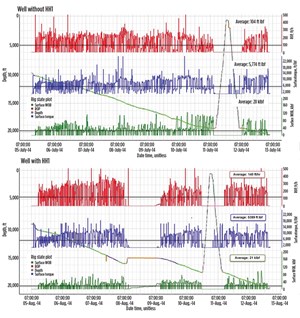
FIELD OBSERVATIONS
To assess the drilling rate outcome, an in-depth analysis and visualization was performed to compare HH1 thermally coated drillstrings with their bare-pipe counterparts. The impartial analysis, which was conducted using the Etech VuMax real-time drilling monitoring and optimization software package, examined sample Bakken wells of comparable trajectory, lithology, formation tops, bottomhole assembly (BHA) configurations, drilling practices and the like, Fig. 3. The comparable ROPs were analyzed, as well as the mechanical specific energy (MSE), which is a function of basic drilling parameters, such as surface WOB, RPM, surface torque, bit diameter and the ROP. The HH1-coated drill pipe consistently demonstrated up to 30% higher ROP than non-treated drill pipe.
Along with noticeable ROP improvement, the analysis of six Bakken wells also noted faster tripping-out speeds at 1,000-ft depth intervals for the HH1-coated drill pipe, as shown in Fig. 4. The off-bottom torque and tripping drag loads were modeled with a sensitivity to friction factor. The measured loads, as achieved and recorded by the monitoring software package, were overlaid on the models to determine the actual friction factor. The offset wells that were drilled using drill pipe treated with HH1 exhibited a friction factor while tripping, ranging from 0.20 to 0.30. The two wells that were drilled using non-treated drill pipe showed a friction factor while tripping that ranged from 0.25 to 0.35.
REDUCED DP COSTS
XTO Energy employed the thermally sprayed, HH1 wear band technology in a 40-well drilling campaign, targeting the Bakken and underlying Three Forks shales, with a primary objective to reduce costs associated with premature drill pipe replacement. The well geometries typically were programmed with ±10,000-ft laterals (±20,000 ft, MD), thus generating high rates of friction and drill pipe wear. Accordingly, between 11 and 21 joints/well were being graded as DBR after an average two wells/month.
Prior to the incorporation of the wear band coating, the operator was replacing, on average, 720 joints of 4-in. drill pipe every three years, at a cost of $1.296 million. In the subsequent multi-well drilling program with the same well trajectories, use of the wear band technology eliminated the DBR-induced drill pipe replacements seen in earlier wells, resulting in an expense-adjusted savings of $817,000. For comparison, a typical Bakken drillstring comprising 370 joints in the lateral was replaced after 1.5 years of drilling up to 15 wells/yr, whereas the initial thermal coating enabled three years of service and an additional 23 wells and upwards of 380,000 ft of lateral sections to be drilled with a single drillstring.
Ancillary cost-savings also were realized through reductions in pipe inspection frequency and scope, as well as mud lubricant consumption. Whereas full-blown inspections were required previously after every five wells at a cost of $200,000, drill pipe with the HH1 coating required only a visual inspection after five wells, with the comprehensive inspection only mandated after every 40 wells, for a total savings of $60,000 to $140,000. Additionally, as the HH1-coated pipe delivered an appreciably lower CoF upon contact with the wellbore/casing, considerably less volume of lubrication additive was required for the WBM used in the Bakken wells. Hence, upwards of $300,000 was saved that otherwise would have been spent for WBM lubricants. Furthermore, logistics-related costs were reduced summarily with the installation of a thermal spray facility in Dickinson, N.D., operated by Veritas Drilling Solutions. ![]()
REFERENCES
- U.S. Patent No. 7,487,840 B2, “Wear-resistant layer for downhole well equipment,” WearSox LP, Feb. 10, 2009.
- Redlinger, T. M., and J. McCormick, “A historical review of drillpipe capabilities and the triggers for change,” SPE paper 139410, presented at the SPE/IADC Drilling Conference and Exhibition, Amsterdam, The Netherlands, March 1-3, 2011.
- Shepard, J. S., “Drillpipe management extends drillstring life,” Oil & Gas Journal, Oct. 28, 1991.
- Brown, J., “Diligent hardband management protects drillstrings, reduces repair costs,” World Oil, August 2016, pp. 35-39.
- Mobley, J. C., “Current hardbanding techniques protect pipe, casing,” Drilling Contractor, March/April 2005.
- Rodman, D. W. and G. Swietlik, “Drillstring sub cuts torque and casing wear,” Oil and Gas Journal, Oct. 14, 1996.
- Dushaishi, M. F., “Investigation of drillstring vibration reduction tools,” master’s thesis, Missouri University of Science and Technology, Spring 2012.
- Baez, F. and A. Alali, “Drilling performance improvements in gas shale plays, using a novel drilling agitator device,” AADE paper 11-NTCE-47, presented at the AADE National Technical Conference and Exhibition, Houston, Texas, April 12-14, 2011.
- Schamp, J. H., B. L. Estes and S. R. Keller, “Torque reduction techniques in ERD wells,” IADC/SPE paper 98969, presented at the IADC/SPE Drilling Conference, Miami, Florida, Feb. 21-23,
- Doering, A. E. R., D. R. Dank, S. E. Mahmoud and J. L. Scott, “Evaluation of worn tubulars from DEA-42 and small-scale casing wear testers,” OTC paper 21978, presented at the Offshore Technology Conference, Houston, Texas, May 2-5, 2011.
- Coiled tubing drilling’s role in the energy transition (March 2024)
- Digital tool kit enhances real-time decision-making to improve drilling efficiency and performance (February 2024)
- E&P outside the U.S. maintains a disciplined pace (February 2024)
- Prices and governmental policies combine to stymie Canadian upstream growth (February 2024)
- U.S. operators reduce activity as crude prices plunge (February 2024)
- U.S. producing gas wells increase despite low prices (February 2024)

